

Hurleys esl modifications. Seven Strategies for Differentiating Instruction for English Learners - ASCD Inservice. Here are seven key strategies that my co-author Debbie Zacarian and I believe should be used by classroom and subject area teachers to differentiate content area information for beginning level English learners (ELs). 1.
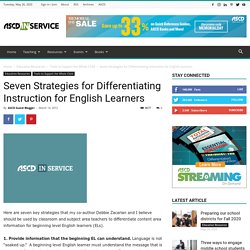
Provide information that the beginning EL can understand. Language is not “soaked up.” A beginning level English learner must understand the message that is conveyed. Simple English Helper Tool. How can I support ELLs in my classroom? — Penn State College of Education. Provide a welcoming classroom environment Creating a positive learning environment is important for supporting the growth of all students.
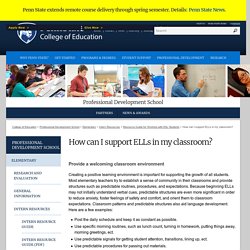
Most elementary teachers try to establish a sense of community in their classrooms and provide structures such as predictable routines, procedures, and expectations. Because beginning ELLs may not initially understand verbal cues, predictable structures are even more significant in order to reduce anxiety, foster feelings of safety and comfort, and orient them to classroom expectations. Classroom patterns and predictable structures also aid language development.
Here are a few examples: Post the daily schedule and keep it as constant as possible.Use specific morning routines, such as lunch count, turning in homework, putting things away, morning greetings, ect.Use predictable signals for getting student attention, transitions, lining up, ect.Use predictable procedures for passing out materials. Know and include the student Modify your speech Modify Texts. : Adjusting Lessons for ESL/ELL Students. Wikipedia. Should Students Speak Only English in Class? Here is a seemingly easy question: Should a policy of English only be put into place in the English learning classroom?
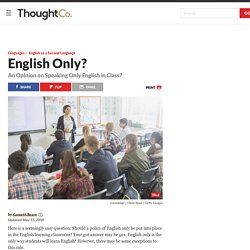
Your gut answer may be yes, English only is the only way students will learn English! However, there may be some exceptions to this rule. Can-Do Descriptors: A Free Tool for ESL Differentiation. Nine Strategies for Reaching All Learners in English Language Arts. In order to maximize the benefits of ELT for students, I looked for ways to fine tune my approach to teaching individualized learning in my English language arts classroom. One of the instructional models that informs my approach to teaching individualized learning is the Readers and Writers Workshop. This approach proved very helpful in optimizing ELT. Readers and Writers Workshop: An Instructional Model. Helping ESL students understand written texts. Introduction Every day in school and at home ESL students have many different texts* to read.
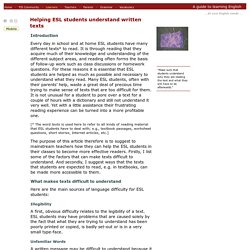
It is through reading that they acquire much of their knowledge and understanding of the different subject areas, and reading often forms the basis of follow-up work such as class discussions or homework questions. For these reasons it is essential that ESL students are helped as much as possible and necessary to understand what they read. Many ESL students, often with their parents’ help, waste a great deal of precious time trying to make sense of texts that are too difficult for them.
It is not unusual for a student to pore over a text for a couple of hours with a dictionary and still not understand it very well. Improving Writing Skills: ELLs and the Joy of Writing. "The meaning of even a single word is rather more complex than one might imagine.
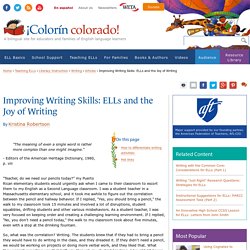
" - Editors of the American Heritage Dictionary, 1980, p. viii "Teacher, do we need our pencils today? " How I Teach My English-Language Learners to Love Writing. Free Printable Worksheets for ESL Teachers and Students. Most of the free printable worksheets on EnglishHints.com can be used online or downloaded for use whenever you want.
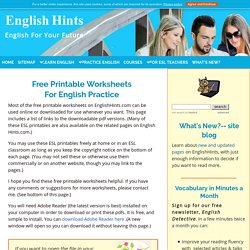
This page includes a list of links to the downloadable pdf versions. (Many of these ESL printables are also available on the related pages on English Hints.com.) You may use these ESL printables freely at home or in an ESL classroom as long as you keep the copyright notice on the bottom of each page. (You may not sell these or otherwise use them commercially or on another website, though you may link to the pages.) I hope you find these free printable worksheets helpful. You will need Adobe Reader (the latest version is best) installed on your computer in order to download or print these pdfs. If you want to open the file in your browser window, just click on the link for each pdf.
When you are ready to use it, locate the place on your computer where you saved it, and double click to open it. Vocabulary Improvement Worksheets. How to Use a Visual Dictionary. It's important to know how to use a visual dictionary as an English learner.
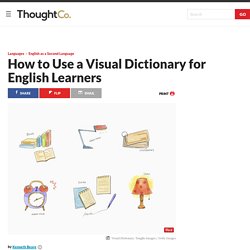
In fact, I'd say that along with a collocation dictionary, a visual dictionary can be a secret weapon when it comes to learning new vocabulary. Of course, you'll always need a standard learner's dictionary, but using these other types will really help you expand your vocabulary quickly. What's the difference between a Visual Dictionary and a "Normal" Dictionary? A visual dictionary teaches through pictures. It shows you the meaning, rather than telling you the meaning of a word. Visual Dictionary Differences Using a standard dictionary requires you to look up a word alphabetically. One negative aspect of visual dictionaries is that they do not provide words that are in similar (or opposite) in meaning.
Many visual dictionaries do not provide pronunciation for individual words. ESOL Online. EFL Resources. Concept Mapping for ELLs. Make-a-Map, our IdeaphoraⓇ-powered concept mapping tool, is officially live on BrainPOP ELL!
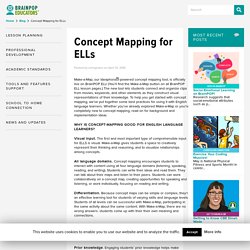
(You’ll find the Make-a-Map button on all BrainPOP ELL lesson pages.) The new tool lets students connect and organize clips from movies, keywords, and other elements as they construct visual representations of their knowledge. To help you get started with concept mapping, we’ve put together some best practices for using it with English language learners. Whether you’ve already explored Make-a-Map or you’re completely new to concept mapping, read on for background and implementation ideas. Visual input. All language domains. Differentiation. English news and easy articles for students of English.
Zidrich ELL. EnglishClub - Learn or Teach English Today. Dave's ESL Cafe. Eslflow's English language teaching resource for ideas and lessons plans. Achieve3000. Access the right solutions to meet the needs of emerging, developing, and long-term English language learners.
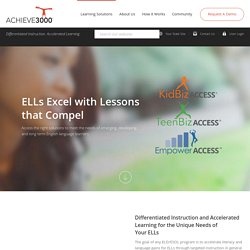
Collaborative Writing, Common Core, and ELLs. Editor's note: This second post in a three-part series is adapted from the new book Navigating the Common Core With English-Language Learners by Larry Ferlazzo and his co-author Katie Hull Sypnieski, an English and ELL/ESL teacher in the Sacramento City Unified School District.
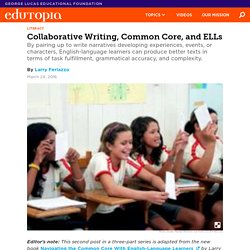
Student collaboration is only mentioned in the writing standard related to using technology for developing and publishing writing, but that doesn't mean that it can't be an important strategy to help meet the standards in this domain. In addition to helping students develop the explicit academic knowledge listed in the standards, collaborative writing has been found to be particularly helpful (PDF) to English-language learners (ELLs) in lowering anxiety and increasing self-confidence and motivation.
Storytelling We have long used a fun and simple collaborative storytelling exercise. We still like it and sometimes use it in the same way. In our new version, students work in pairs, instead of groups of three. Tracking Strategies – Supporting English Language Learners. The downloadable tracking sheets can be used for recording proficiency levels at different points throughout the school year e.g., when students enter the school system, at different report periods, and on an ongoing basis. There is a set of tracking sheets (Listening, Speaking, Reading and Writing) for each division: grades 1-3, 4-6, 7-9 and 10-12.
Kindergarten tracking sheets are for Listening and Speaking only. Consider the following strategies for tracking students’ language proficiency: Select one student per day to focus on. ELL - Definition for English-Language Learners from Merriam-Webster's Learner's Dictionary. Concept Map ELL Strategies. 77496 Free ESL, EFL worksheets made by teachers for teachers. ESL Library. Easier English Listening and Lesson Plans. Randall's ESL Cyber Listening Lab - For English Students. EasyWrite: Write clearly using only 1,000 commonly used words. 5 Things English Learners Need From Classroom Teachers.
4.8 million. That’s the number of English language learners enrolled in K-12 schools, according to the U.S. Department of Education. In other words, at least one out of every 10 students in classrooms today is an English language learner (ELL). As the number of ELLs continues to increase at lightning speed, the pressure is on for classroom teachers to examine their practices and find new ways of meeting the needs of this ever-growing population of students. As an English as a second language (ESL) specialist, teachers often come to me full of questions about what they should be doing to help language learners in their classrooms. In order to help educators on their way to becoming more confident instructors of ELLs, I’ve put together a list of the top ten things ELL students need from their classroom teachers.
Here are the first five: Visuals This video file cannot be played. ELL strategies & Misconceptions - Home.